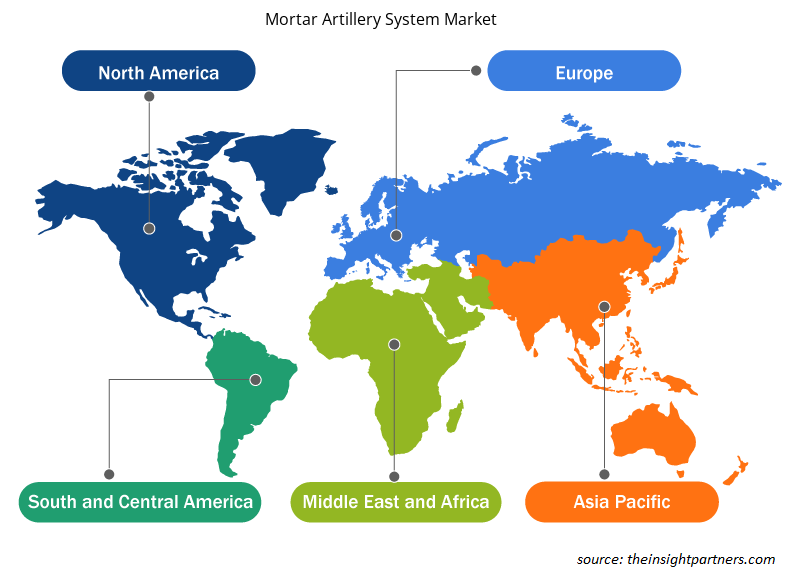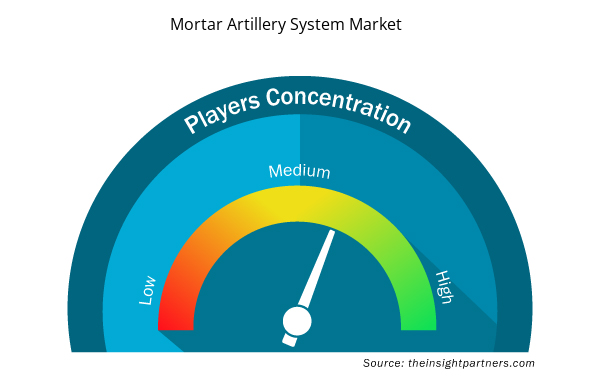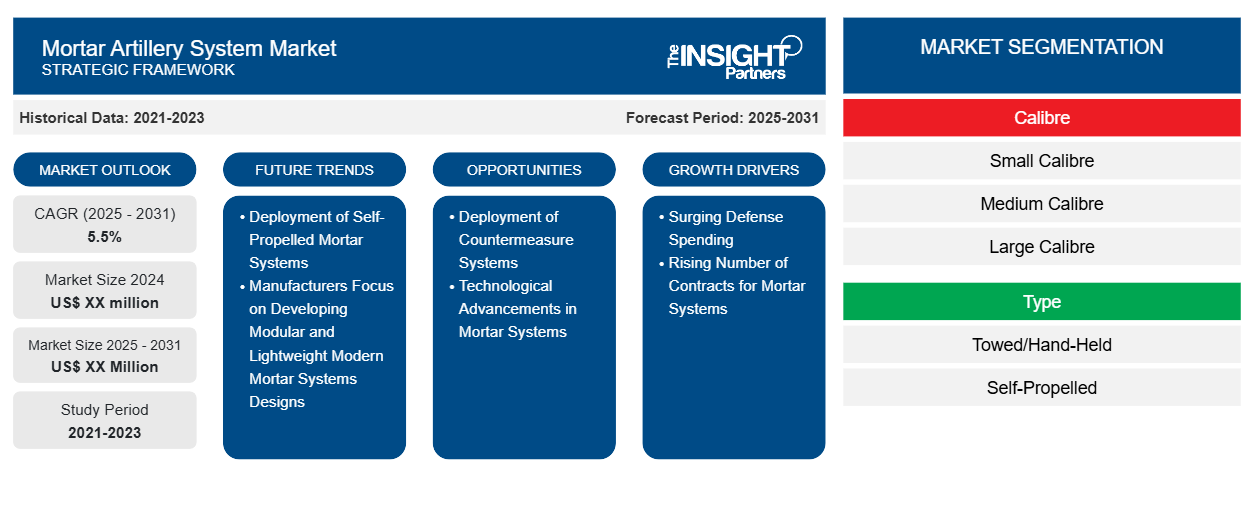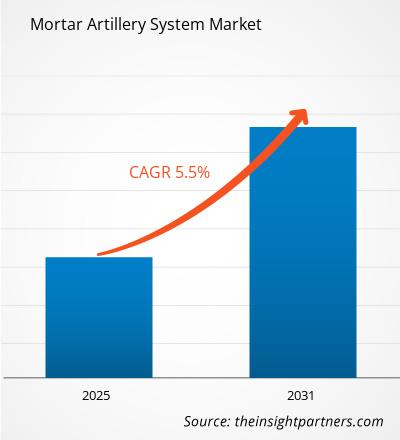Si prevede che il mercato dei sistemi di artiglieria mortaio registrerà un CAGR del 5,5% dal 2024 al 2031, con una dimensione di mercato in espansione da XX milioni di dollari nel 2024 a XX milioni di dollari entro il 2031.
Il report è segmentato per Calibro (Calibro piccolo, Calibro medio, Calibro grande); Tipo (Trainato/Manuale, Semovente). L'analisi globale è ulteriormente suddivisa a livello regionale e nei principali Paesi. Il report offre il valore in USD per l'analisi e i segmenti di cui sopra.
Scopo del rapporto
Il report Mortar Artillery System Market di The Insight Partners mira a descrivere il panorama attuale e la crescita futura, i principali fattori trainanti, le sfide e le opportunità. Ciò fornirà spunti a vari stakeholder aziendali, come:
- Fornitori/produttori di tecnologia: per comprendere le dinamiche di mercato in evoluzione e conoscere le potenziali opportunità di crescita, consentendo loro di prendere decisioni strategiche informate.
- Investitori: condurre un'analisi completa delle tendenze in merito al tasso di crescita del mercato, alle proiezioni finanziarie del mercato e alle opportunità esistenti lungo la catena del valore.
- Enti di regolamentazione: regolamentano le politiche e le attività di controllo sul mercato allo scopo di ridurre al minimo gli abusi, preservare la fiducia degli investitori e sostenere l'integrità e la stabilità del mercato.
Segmentazione del mercato del sistema di artiglieria mortaio
Calibro
- Piccolo calibro
- Calibro medio
- Grande calibro
Tipo
- Trainato/portato a mano
- Semovente
Personalizza questo report in base alle tue esigenze
Riceverai la personalizzazione gratuita di qualsiasi report, comprese parti di questo report, o analisi a livello nazionale, pacchetto dati Excel, oltre a usufruire di grandi offerte e sconti per start-up e università
- Scopri le principali tendenze di mercato in questo rapporto.Questo campione GRATUITO includerà analisi di dati che spaziano dalle tendenze di mercato alle stime e alle previsioni.
Fattori trainanti della crescita del mercato dei sistemi di artiglieria mortaio
- Aumento della spesa per la difesa: l'evoluzione dello scenario della guerra moderna ha costretto i governi di vari paesi in tutto il mondo ad assegnare fondi significativi e aiuti finanziari alle rispettive forze di difesa e militari. L'assegnazione del budget per la difesa supporta l'esercito e le forze militari per ottenere tecnologie e attrezzature migliorate da sviluppatori nazionali o internazionali. D'altro canto, gli aggiornamenti dei veicoli militari e dell'esercito sono in aumento a causa della crescente assegnazione del budget per la difesa.
- Aumento del numero di contratti per sistemi di mortaio: i produttori che operano nel mercato dei sistemi di mortaio si concentrano fortemente sulla collaborazione con diversi governi e forze armate per comprendere le rispettive richieste e offrire loro soluzioni adatte. Le forze militari di vari paesi stanno fornendo numerosi contratti ai produttori di sistemi di artiglieria per procurarsi diversi sistemi di comunicazione, sorveglianza e navigazione. Inoltre, le forze di difesa di diverse nazioni stanno investendo in modo sostanziale nell'acquisto di sistemi di artiglieria come artiglieria missilistica, mortai e obici. I sistemi di artiglieria sono affidabili per abbattere bersagli a corto, medio e lungo raggio.
Tendenze future del mercato del sistema di artiglieria mortaio
- Dispiegamento di sistemi di mortai semoventi: la crescente applicazione di sistemi senza pilota per vari scopi, tra cui la consegna di armi, la sorveglianza o il rilevamento, aumenta la domanda di sistemi di artiglieria semoventi. La crescente adozione di sistemi di artiglieria semoventi riduce le sfide logistiche e di trasporto affrontate durante lo spostamento di qualsiasi sistema di artiglieria. I sistemi di artiglieria semoventi consentono la riduzione della manodopera operativa richiesta per azionare qualsiasi sistema di artiglieria come obici o artiglierie a razzo.
- I produttori si concentrano sullo sviluppo di sistemi di mortaio moderni modulari e leggeri: la tendenza verso sistemi di mortaio modulari e leggeri sta diventando sempre più importante. I moderni sistemi di mortaio vengono progettati per essere più modulari, consentendo una più facile personalizzazione e integrazione con altri sistemi militari. La modularità dei mortai consente alle forze armate di adattarli a varie situazioni di combattimento, dal supporto alla fanteria all'artiglieria montata sui veicoli. Inoltre, i design leggeri stanno migliorando la portabilità e la mobilità dei sistemi di mortaio, consentendo un dispiegamento più rapido in ambienti di combattimento dinamici. Queste tendenze stanno guidando lo sviluppo di sistemi di mortaio più flessibili, adattabili e dispiegabili, rendendoli più attraenti per le forze militari alla ricerca di soluzioni versatili.
Opportunità di mercato per il sistema di artiglieria mortaio
- Dispiegamento di sistemi di contromisure: il mutevole scenario geopolitico mondiale aumenta la necessità di sistemi di contromisure di difesa efficaci. La tensione costante tra nazioni come Russia-Ucraina, India-Cina, Pakistan-India, Israele-Palestina e Stati Uniti-Cina sta costringendo i loro governi a rafforzare le rispettive forze armate, il che sta anche spingendo l'acquisto di sistemi di guerra come diversi tipi di mortai e obici. Quindi, le forze armate di diversi paesi stanno investendo nell'acquisto di sistemi di artiglieria come artiglieria missilistica terra-aria, obici semoventi, sistemi di allerta precoce e sistemi di sorveglianza delle frontiere.
- Progressi tecnologici nei sistemi di mortaio: mentre gli eserciti cercano di migliorare l'efficacia dei loro sistemi di artiglieria, c'è una significativa opportunità di innovazione nella tecnologia alla base dei sistemi di artiglieria mortaio. Un'area chiave è l'integrazione di munizioni intelligenti e guidate di precisione (PGM) per mortai. Questi proiettili avanzati offrono una maggiore precisione, riducendo al minimo i danni collaterali e garantendo che i bersagli vengano colpiti con maggiore precisione. Inoltre, sistemi di caricamento automatizzati, sistemi di controllo del fuoco migliorati e tecnologie di comunicazione avanzate stanno trasformando i sistemi di mortaio, rendendoli più efficienti ed efficaci negli scenari di combattimento moderni. I produttori possono capitalizzare questi progressi tecnologici sviluppando e offrendo soluzioni di artiglieria mortaio più sofisticate e ad alta tecnologia.
Approfondimenti regionali sul mercato del sistema di artiglieria mortaio
Le tendenze regionali e i fattori che influenzano il mercato del sistema di artiglieria mortaio durante il periodo di previsione sono stati ampiamente spiegati dagli analisti di Insight Partners. Questa sezione discute anche i segmenti e la geografia del mercato del sistema di artiglieria mortaio in Nord America, Europa, Asia Pacifico, Medio Oriente e Africa e America meridionale e centrale.

- Ottieni i dati specifici regionali per il mercato del sistema di artiglieria mortaio
Ambito del rapporto di mercato del sistema di artiglieria mortaio
| Attributo del report | Dettagli |
|---|---|
| Dimensioni del mercato nel 2024 | XX milioni di dollari USA |
| Dimensioni del mercato entro il 2031 | XX milioni di dollari USA |
| CAGR globale (2025 - 2031) | 5,5% |
| Dati storici | 2021-2023 |
| Periodo di previsione | 2025-2031 |
| Segmenti coperti | Per calibro
|
| Regioni e Paesi coperti | America del Nord
|
| Leader di mercato e profili aziendali chiave |
|
Densità dei player del mercato del sistema di artiglieria mortaio: comprendere il suo impatto sulle dinamiche aziendali
Il mercato del Mortar Artillery System Market sta crescendo rapidamente, spinto dalla crescente domanda degli utenti finali dovuta a fattori quali l'evoluzione delle preferenze dei consumatori, i progressi tecnologici e una maggiore consapevolezza dei vantaggi del prodotto. Con l'aumento della domanda, le aziende stanno ampliando le loro offerte, innovando per soddisfare le esigenze dei consumatori e capitalizzando sulle tendenze emergenti, il che alimenta ulteriormente la crescita del mercato.
La densità degli operatori di mercato si riferisce alla distribuzione di aziende o società che operano in un particolare mercato o settore. Indica quanti concorrenti (operatori di mercato) sono presenti in un dato spazio di mercato in relazione alle sue dimensioni o al valore di mercato totale.
Le principali aziende che operano nel mercato dei sistemi di artiglieria mortaio sono:
- Sistemi BAE
- Sistemi di terra Denel
- Azienda
- Sistemi di artiglieria e tattica della General Dynamics
- Gruppo Hanwha
Disclaimer : le aziende elencate sopra non sono classificate secondo un ordine particolare.

- Ottieni una panoramica dei principali attori del mercato dei sistemi di artiglieria da mortaio
Punti chiave di vendita
- Copertura completa: il rapporto copre in modo completo l'analisi di prodotti, servizi, tipologie e utenti finali del mercato dei sistemi di artiglieria mortaio, fornendo una panoramica olistica.
- Analisi degli esperti: il rapporto è compilato sulla base della conoscenza approfondita di esperti e analisti del settore.
- Informazioni aggiornate: il rapporto garantisce la pertinenza aziendale grazie alla copertura di informazioni recenti e tendenze nei dati.
- Opzioni di personalizzazione: questo report può essere personalizzato per soddisfare le esigenze specifiche del cliente e adattarsi in modo appropriato alle strategie aziendali.
Il rapporto di ricerca sul mercato dei sistemi di artiglieria da mortaio può, quindi, aiutare a guidare il percorso di decodificazione e comprensione dello scenario del settore e delle prospettive di crescita. Sebbene possano esserci alcune preoccupazioni valide, i vantaggi complessivi di questo rapporto tendono a superare gli svantaggi.
- Analisi storica (2 anni), anno base, previsione (7 anni) con CAGR
- Analisi PEST e SWOT
- Valore/volume delle dimensioni del mercato - Globale, regionale, nazionale
- Industria e panorama competitivo
- Set di dati Excel



Report Coverage
Revenue forecast, Company Analysis, Industry landscape, Growth factors, and Trends

Segment Covered
This text is related
to segments covered.

Regional Scope
North America, Europe, Asia Pacific, Middle East & Africa, South & Central America

Country Scope
This text is related
to country scope.
Domande frequenti
Some of the customization options available based on request are additional 3-5 company profiles and country-specific analysis of 3-5 countries of your choice. Customizations are to be requested/discussed before making final order confirmation, as our team would review the same and check the feasibility.
The report can be delivered in PDF/PPT format; we can also share excel dataset based on the request.
Some of the major trends driving the mortar artillery system market are:
1. Deployment of Self-Propelled Mortar Systems
The major factors driving the mortar artillery system market are:
1. Surging Defense Spending
2. Rising Number of Contracts for Mortar Systems
The Mortar Artillery System Market is estimated to witness a CAGR of 5.5% from 2023 to 2031
Trends and growth analysis reports related to Aerospace and Defense : READ MORE..
1. BAE Systems
2. Denel Land Systems
3. Elbit Systems Ltd.
4. General Dynamics Ordnance and Tactical Systems
5. Hanwha Group
6. IMI Systems Ltd.
7. Lockheed Martin Corporation
8. Rheinmetall AG
9. RUAG Group
10. ST Engineering
The Insight Partners performs research in 4 major stages: Data Collection & Secondary Research, Primary Research, Data Analysis and Data Triangulation & Final Review.
- Data Collection and Secondary Research:
As a market research and consulting firm operating from a decade, we have published and advised several client across the globe. First step for any study will start with an assessment of currently available data and insights from existing reports. Further, historical and current market information is collected from Investor Presentations, Annual Reports, SEC Filings, etc., and other information related to company’s performance and market positioning are gathered from Paid Databases (Factiva, Hoovers, and Reuters) and various other publications available in public domain.
Several associations trade associates, technical forums, institutes, societies and organization are accessed to gain technical as well as market related insights through their publications such as research papers, blogs and press releases related to the studies are referred to get cues about the market. Further, white papers, journals, magazines, and other news articles published in last 3 years are scrutinized and analyzed to understand the current market trends.
- Primary Research:
The primarily interview analysis comprise of data obtained from industry participants interview and answers to survey questions gathered by in-house primary team.
For primary research, interviews are conducted with industry experts/CEOs/Marketing Managers/VPs/Subject Matter Experts from both demand and supply side to get a 360-degree view of the market. The primary team conducts several interviews based on the complexity of the markets to understand the various market trends and dynamics which makes research more credible and precise.
A typical research interview fulfils the following functions:
- Provides first-hand information on the market size, market trends, growth trends, competitive landscape, and outlook
- Validates and strengthens in-house secondary research findings
- Develops the analysis team’s expertise and market understanding
Primary research involves email interactions and telephone interviews for each market, category, segment, and sub-segment across geographies. The participants who typically take part in such a process include, but are not limited to:
- Industry participants: VPs, business development managers, market intelligence managers and national sales managers
- Outside experts: Valuation experts, research analysts and key opinion leaders specializing in the electronics and semiconductor industry.
Below is the breakup of our primary respondents by company, designation, and region:

Once we receive the confirmation from primary research sources or primary respondents, we finalize the base year market estimation and forecast the data as per the macroeconomic and microeconomic factors assessed during data collection.
- Data Analysis:
Once data is validated through both secondary as well as primary respondents, we finalize the market estimations by hypothesis formulation and factor analysis at regional and country level.
- Macro-Economic Factor Analysis:
We analyse macroeconomic indicators such the gross domestic product (GDP), increase in the demand for goods and services across industries, technological advancement, regional economic growth, governmental policies, the influence of COVID-19, PEST analysis, and other aspects. This analysis aids in setting benchmarks for various nations/regions and approximating market splits. Additionally, the general trend of the aforementioned components aid in determining the market's development possibilities.
- Country Level Data:
Various factors that are especially aligned to the country are taken into account to determine the market size for a certain area and country, including the presence of vendors, such as headquarters and offices, the country's GDP, demand patterns, and industry growth. To comprehend the market dynamics for the nation, a number of growth variables, inhibitors, application areas, and current market trends are researched. The aforementioned elements aid in determining the country's overall market's growth potential.
- Company Profile:
The “Table of Contents” is formulated by listing and analyzing more than 25 - 30 companies operating in the market ecosystem across geographies. However, we profile only 10 companies as a standard practice in our syndicate reports. These 10 companies comprise leading, emerging, and regional players. Nonetheless, our analysis is not restricted to the 10 listed companies, we also analyze other companies present in the market to develop a holistic view and understand the prevailing trends. The “Company Profiles” section in the report covers key facts, business description, products & services, financial information, SWOT analysis, and key developments. The financial information presented is extracted from the annual reports and official documents of the publicly listed companies. Upon collecting the information for the sections of respective companies, we verify them via various primary sources and then compile the data in respective company profiles. The company level information helps us in deriving the base number as well as in forecasting the market size.
- Developing Base Number:
Aggregation of sales statistics (2020-2022) and macro-economic factor, and other secondary and primary research insights are utilized to arrive at base number and related market shares for 2022. The data gaps are identified in this step and relevant market data is analyzed, collected from paid primary interviews or databases. On finalizing the base year market size, forecasts are developed on the basis of macro-economic, industry and market growth factors and company level analysis.
- Data Triangulation and Final Review:
The market findings and base year market size calculations are validated from supply as well as demand side. Demand side validations are based on macro-economic factor analysis and benchmarks for respective regions and countries. In case of supply side validations, revenues of major companies are estimated (in case not available) based on industry benchmark, approximate number of employees, product portfolio, and primary interviews revenues are gathered. Further revenue from target product/service segment is assessed to avoid overshooting of market statistics. In case of heavy deviations between supply and demand side values, all thes steps are repeated to achieve synchronization.
We follow an iterative model, wherein we share our research findings with Subject Matter Experts (SME’s) and Key Opinion Leaders (KOLs) until consensus view of the market is not formulated – this model negates any drastic deviation in the opinions of experts. Only validated and universally acceptable research findings are quoted in our reports.
We have important check points that we use to validate our research findings – which we call – data triangulation, where we validate the information, we generate from secondary sources with primary interviews and then we re-validate with our internal data bases and Subject matter experts. This comprehensive model enables us to deliver high quality, reliable data in shortest possible time.


 Ottieni un campione gratuito per questo repot
Ottieni un campione gratuito per questo repot